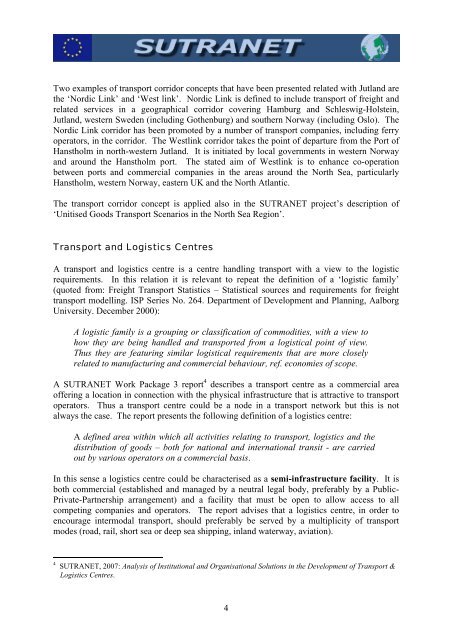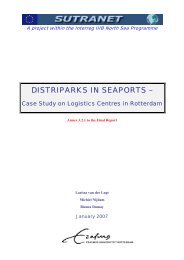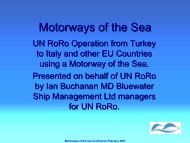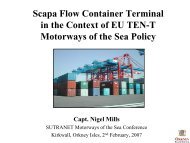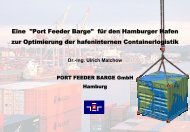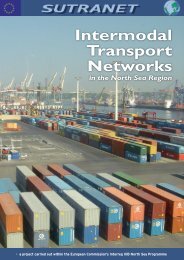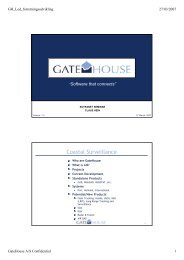TRANSPORT SYSTEMS CONCEPTS and DEFINITIONS - Sutranet
TRANSPORT SYSTEMS CONCEPTS and DEFINITIONS - Sutranet
TRANSPORT SYSTEMS CONCEPTS and DEFINITIONS - Sutranet
Create successful ePaper yourself
Turn your PDF publications into a flip-book with our unique Google optimized e-Paper software.
Two examples of transport corridor concepts that have been presented related with Jutl<strong>and</strong> are<br />
the ‘Nordic Link’ <strong>and</strong> ‘West link’. Nordic Link is defined to include transport of freight <strong>and</strong><br />
related services in a geographical corridor covering Hamburg <strong>and</strong> Schleswig-Holstein,<br />
Jutl<strong>and</strong>, western Sweden (including Gothenburg) <strong>and</strong> southern Norway (including Oslo). The<br />
Nordic Link corridor has been promoted by a number of transport companies, including ferry<br />
operators, in the corridor. The Westlink corridor takes the point of departure from the Port of<br />
Hanstholm in north-western Jutl<strong>and</strong>. It is initiated by local governments in western Norway<br />
<strong>and</strong> around the Hanstholm port. The stated aim of Westlink is to enhance co-operation<br />
between ports <strong>and</strong> commercial companies in the areas around the North Sea, particularly<br />
Hanstholm, western Norway, eastern UK <strong>and</strong> the North Atlantic.<br />
The transport corridor concept is applied also in the SUTRANET project’s description of<br />
‘Unitised Goods Transport Scenarios in the North Sea Region’.<br />
Transport <strong>and</strong> Logistics Centres<br />
A transport <strong>and</strong> logistics centre is a centre h<strong>and</strong>ling transport with a view to the logistic<br />
requirements. In this relation it is relevant to repeat the definition of a ‘logistic family’<br />
(quoted from: Freight Transport Statistics – Statistical sources <strong>and</strong> requirements for freight<br />
transport modelling. ISP Series No. 264. Department of Development <strong>and</strong> Planning, Aalborg<br />
University. December 2000):<br />
A logistic family is a grouping or classification of commodities, with a view to<br />
how they are being h<strong>and</strong>led <strong>and</strong> transported from a logistical point of view.<br />
Thus they are featuring similar logistical requirements that are more closely<br />
related to manufacturing <strong>and</strong> commercial behaviour, ref. economies of scope.<br />
A SUTRANET Work Package 3 report 4 describes a transport centre as a commercial area<br />
offering a location in connection with the physical infrastructure that is attractive to transport<br />
operators. Thus a transport centre could be a node in a transport network but this is not<br />
always the case. The report presents the following definition of a logistics centre:<br />
A defined area within which all activities relating to transport, logistics <strong>and</strong> the<br />
distribution of goods – both for national <strong>and</strong> international transit - are carried<br />
out by various operators on a commercial basis.<br />
In this sense a logistics centre could be characterised as a semi-infrastructure facility. It is<br />
both commercial (established <strong>and</strong> managed by a neutral legal body, preferably by a Public-<br />
Private-Partnership arrangement) <strong>and</strong> a facility that must be open to allow access to all<br />
competing companies <strong>and</strong> operators. The report advises that a logistics centre, in order to<br />
encourage intermodal transport, should preferably be served by a multiplicity of transport<br />
modes (road, rail, short sea or deep sea shipping, inl<strong>and</strong> waterway, aviation).<br />
4 SUTRANET, 2007: Analysis of Institutional <strong>and</strong> Organisational Solutions in the Development of Transport &<br />
Logistics Centres.<br />
4


